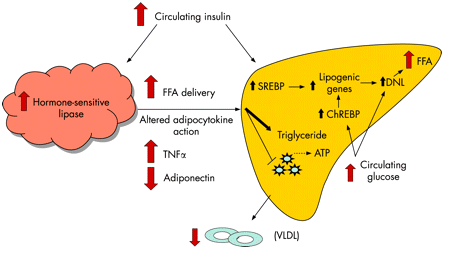 Compared with our ancestors, Western societies today lead a lifestyle that is much more sedentary, probably as a result of cultural changes stemming from modern socio-economic morays. Taking into account differences in body size, our energy expenditure per kilogram of body weight has been estimated to be <40% of that of our prehistoric ancestors.[1] Current estimates suggest that 7 out of 10 adults are inactive or lack adequate conditioning,[2] and this lack of adequate exercise, combined with dietary indiscretion, has contributed to the worldwide epidemic of obesity and non-alcoholic fatty liver disease (NAFLD). NAFLD, is now considered to be around 20–30% prevalence in Western countries.
Compared with our ancestors, Western societies today lead a lifestyle that is much more sedentary, probably as a result of cultural changes stemming from modern socio-economic morays. Taking into account differences in body size, our energy expenditure per kilogram of body weight has been estimated to be <40% of that of our prehistoric ancestors.[1] Current estimates suggest that 7 out of 10 adults are inactive or lack adequate conditioning,[2] and this lack of adequate exercise, combined with dietary indiscretion, has contributed to the worldwide epidemic of obesity and non-alcoholic fatty liver disease (NAFLD). NAFLD, is now considered to be around 20–30% prevalence in Western countries.

Omega 3 Intake
Increased dietary intakes of omega-3 fatty acids from marine sources may benefit people with non-alcoholic fatty liver disease (NAFLD), says a new review of the literature. Previous studies have implicated omega-3 in protective benefits against obesity-related conditions. Many studies already demonstrate the health benefits of the omega-3 fatty acids eicosapentaenoic acid (EPA, C20:5 n-3) and docosahexaenoic acid (DHA, C22:6 n-3). Including cardiovascular health, cognitive health, mood, behaviour, eye health, cancer risk reduction, and improved infant development.
They have several potential mechanisms of action, the most important being to alter hepatic gene expression, thereby switching intracellular metabolism from lipogenesis and storage to fatty acid oxidation and catabolism. There is also evidence that they improve insulin sensitivity, are anti-inflammatory and reduce TNF levels so offering several potential therapeutic mechanisms.
Background: Non-alcoholic fatty liver disease (NAFLD) affects 10-35% of the adult population worldwide; there is no consensus on its treatment. Omega-3 fatty acids have proven benefits for hyperlipidaemia and cardiovascular disease, and have recently been suggested as a treatment for NAFLD.
Aim: To review the evidence base for omega-3 fatty acids in NAFLD and critically appraise the literature relating to human trials.
Methods: A Medline and PubMed search was performed to identify relevant literature using search terms ‘omega-3’, ‘N-3 PUFA’, ‘eicosapentaenoic acid’, ‘docosahexaenoic acid’, ‘non-alcoholic fatty liver disease’ and ‘NAFLD’.
Results: Omega-3 fatty acids are important regulators of hepatic gene transcription. Animal studies demonstrate they reduce hepatic steatosis, improve insulin sensitivity and reduce markers of inflammation. Clinical trials in human subjects generally confirm these findings but have significant design inadequacies.
Conclusions: Omega-3 fatty acids are a promising treatment for NAFLD which require to be tested in randomised placebo controlled trials.
Masterton G. S., Plevris J.N., Hayes P.C. omega-3 fatty acids – a promising novel therapy for non-alcoholic fatty liver disease. Alimentary Pharmacology & Therapeutics doi: 10.1111/j.1365-2036.2009.04230.x View Abstract
References
[1] Hambrecht R, & Gielen S (2005). Essay: Hunter-gatherer to sedentary lifestyle. Lancet, 366 Suppl 1 PMID: 16360760
[2] Manson JE, Skerrett PJ, Greenland P, & VanItallie TB (2004). The escalating pandemics of obesity and sedentary lifestyle. A call to action for clinicians. Archives of internal medicine, 164 (3), 249-58 PMID: 14769621
[3] Harrison SA, & Day CP (2007). Benefits of lifestyle modification in NAFLD. Gut, 56 (12), 1760-9 PMID: 17911352





